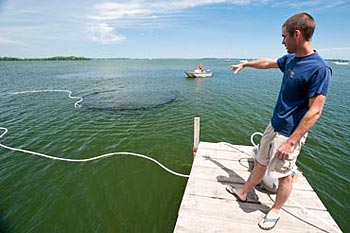Will a well-mixed, warmer lake doom invasive fish?
The rainbow smelt, an invasive fish that threatens native species such as walleye and perch, may soon be feeling the heat — literally.

Jordan Read, a doctoral candidate in civil and environmental engineering, explains the mechanics of a water-mixing experiment as equipment is tested near the Limnology pier on Lake Mendota on July 9, 2009. The experiment, which involves a device that resembles a parachute with an inflatable ring, brings water from the bottom of a lake to the surface and raises the temperature of the deeper water. The experiment has implications for studying the effects of global warming as well as the effects of water temperature change on invasive species in lakes.
Photo: Bryce Richter
In an experiment that could show the way to evicting the unwanted fish from Wisconsin lakes, UW–Madison scientists and engineers hope to experimentally warm Crystal Lake in Vilas County in an effort to selectively wipe out the smelt. Using a device known as a GELI, an apparatus that looks like a submerged trampoline, the researchers will mix the waters of the 83-acre lake to warm the cool, deeper waters where the rainbow smelt thrive.
“As far as I know, this is a completely new idea,” according to UW–Madison researcher Steve Carpenter, a world authority on lakes and a leader of the new study along with civil and environmental engineering Professor Chin Wu.
“For it to work, one needs rather special circumstances,” Carpenter explains. “The species you want to eliminate must be intolerant of warm water, and the warm water must not harm the native species that you wish to keep. That is the case in Crystal Lake and perhaps some other lakes in northern Wisconsin that have been invaded by smelt.”
The idea, according to engineering graduate student Jordan Read, is to use the GELI — which is propelled up and down in the water column using compressed air and pushes water much like the bell of a jellyfish — to warm the deeper waters of the lake by a few degrees to a temperature the invasive fish is unable to tolerate.
“The main goal of the project is to mix the water column to the point where the deeper cold water habitat refuge for smelt is gone,” says Read.
Using the device, the Wisconsin researchers will warm Crystal Lake by about 6 degrees Fahrenheit, bringing the average July temperature of the lake to nearly 66 degrees Fahrenheit, a temperature intended to make things uncomfortable for the invasive fish.
The rainbow smelt is a native of the northeast coast of the United States and was brought to the American Midwest in the 1920s as a potential food source for walleyes, one of Wisconsin’s most prized game fish. But the smelt spread to lakes Michigan and Superior and is now finding its way to many of Wisconsin’s smaller inland lakes.
“Rainbow smelt are delicious, and many people know them as fried smelt,” says Carpenter. “They are also voracious predators that gobble up juveniles of many fish species. They are particularly effective at eating walleye juveniles, and walleyes are often eliminated from inland lakes that are invaded by rainbow smelt.”
The idea behind the Crystal Lake experiment, says Read, the graduate student directing the fieldwork, is to determine if artificially mixing the lake and warming its deeper waters will cause thermal stress for the smelt. The hypothesis, he explains, is that increased temperature will either kill the smelt outright or stress them to the point that survival and reproduction rates are greatly reduced. “The goal is to alter the thermal habitat the fish needs to survive,” he notes of the experiment.
“Fish and most other aquatic invaders take on the temperature of their environment,” says Carpenter, who explains that the rise in temperature should not harm native species such as walleye and bass. “If you warm the lake above the upper lethal temperature that the invaders will tolerate, they will die off.”
The GELI is a radical departure from traditional methods of mixing lakes, says Read. Ordinarily, to alter the water temperature of a body of water the technique of choice is aeration, where compressed air is circulated through the water. The GELI technology could also potentially be used to restore oxygen to small areas of oxygen-depleted water.
“Preliminary measurements found the GELI technology to be much more efficient in comparison with traditional aeration techniques,” says Read, of the 8-meter diameter membrane fitted with a hose-like collar which is alternately filled and emptied of air to raise and lower it in the water column. What’s more, the GELI technology is more environmentally friendly as, unlike aeration, it does not stir up sediments.
